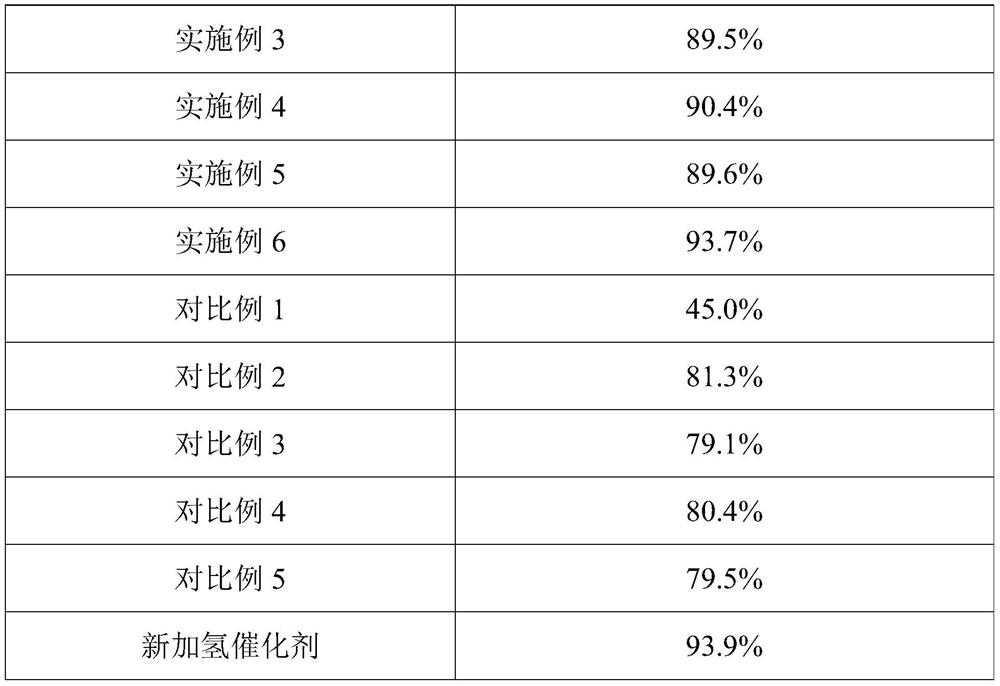A method for regeneration of spent hydrogenation catalyst
A waste hydrogenation catalyst and catalyst technology, applied in the direction of catalyst regeneration/reactivation, catalyst carrier, molecular sieve catalyst, etc., can solve the problems of waste oil, incomplete metal recovery, secondary pollution, etc. The effect of composite utilization and avoiding clogging of micropores
- Summary
- Abstract
- Description
- Claims
- Application Information
AI Technical Summary
Problems solved by technology
Method used
Image
Examples
Embodiment 1
[0034] A method for regenerating a spent hydrogenation catalyst provided in this embodiment comprises the following steps:
[0035] S1. Under the action of the suspension bed hydrogenation catalyst, after the heavy oil raw material - high temperature coal tar is subjected to the suspension bed hydrogenation process, the mixed solution of the spent catalyst and the heavy oil discharged from the bottom of the vacuum tower is automatically backflushed The washed filter is subjected to solid-liquid separation to obtain a filter cake, that is, the spent hydrogenation catalyst;
[0036] S2. Carbonize the spent hydrogenation catalyst at 600°C for 2.2 hours to obtain dehydrated and deoiled catalyst A and dry distillation gas, then remove dust from the dry distillation gas, mix the obtained dust with catalyst A, and mix the dedusted The dry distillation gas is cooled to obtain a mixture of high boiling point oil and water and flammable low boiling point gas. The high boiling point oil ...
Embodiment 2
[0040] A method for regenerating a spent hydrogenation catalyst provided in this embodiment comprises the following steps:
[0041]S1. Under the action of the suspension bed hydrogenation catalyst, after the heavy oil raw material-atmospheric pressure residue is subjected to the suspension bed hydrogenation process, the mixed solution of the spent catalyst and the heavy oil discharged from the bottom of the vacuum tower is used in a plate frame The filter performs solid-liquid separation to obtain the filter residue, that is, the spent hydrogenation catalyst;
[0042] S2. Dry distillation the spent hydrogenation catalyst at 700°C for 2.1 hours to obtain dehydrated and deoiled catalyst A and dry distillation gas, then remove dust from the dry distillation gas, mix the obtained dust with catalyst A, and mix the dedusted The dry distillation gas is cooled to obtain a mixture of high boiling point oil and water and flammable low boiling point gas. The high boiling point oil and wa...
Embodiment 3
[0046] A method for regenerating a spent hydrogenation catalyst provided in this embodiment comprises the following steps:
[0047] S1. Under the action of the suspension bed hydrogenation catalyst, after the mixture of heavy oil raw material - medium and low temperature coal tar and asphalt is subjected to the suspension bed hydrogenation process, the spent catalyst discharged from the bottom of the vacuum tower is mixed with the heavy oil product The liquid is centrifugally separated by a centrifugal separator to obtain a solid residue, that is, a spent hydrogenation catalyst;
[0048] S2. Dry distillation of the spent hydrogenation catalyst at 400°C for 2.5 hours to obtain dehydrated and deoiled catalyst A and dry distillation gas, then dedust the dry distillation gas, mix the obtained dust with catalyst A, and dedust the dedusted The dry distillation gas is cooled to obtain a mixture of high boiling point oil and water and flammable low boiling point gas. The high boiling ...
PUM
 Login to View More
Login to View More Abstract
Description
Claims
Application Information
 Login to View More
Login to View More - R&D
- Intellectual Property
- Life Sciences
- Materials
- Tech Scout
- Unparalleled Data Quality
- Higher Quality Content
- 60% Fewer Hallucinations
Browse by: Latest US Patents, China's latest patents, Technical Efficacy Thesaurus, Application Domain, Technology Topic, Popular Technical Reports.
© 2025 PatSnap. All rights reserved.Legal|Privacy policy|Modern Slavery Act Transparency Statement|Sitemap|About US| Contact US: help@patsnap.com


